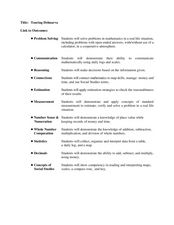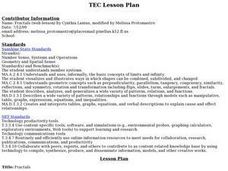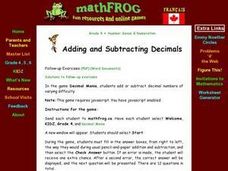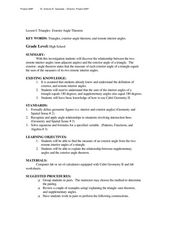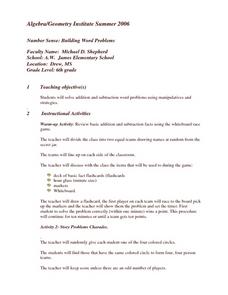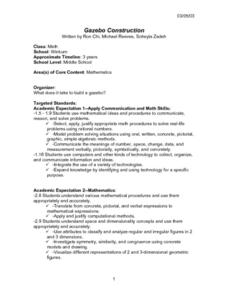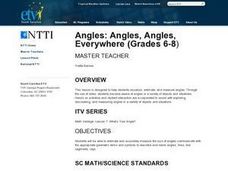Curated OER
Imaginary Trip to South Korea
Students "visit" South Korea through the use of technology, in a fun, and stimulating, detailed project. They arrange travel, make choices, work through a budget, learn history, have exposure to language, and get a sense of what a...
Curated OER
Touring Delmarva
Students plan a trip. In this trip planning lesson, students use a map to find where they would like to visit with a pretend family of 4. They get a specific amount of money and time and need to decide where they will stay and what...
Curated OER
Patterns Here, There, and Everywhere!
Upper graders access the Microsoft Word program and create patterns by utilizing certain keys on the keyboard. They create picket fences, smiley faces, and hearts. It seems that this lesson has as much to do with keyboarding skills as it...
Curated OER
What are Fractals?
Middle and high schoolers identify and analyze fractals and research information using the Internet to locate information about them. They look at fractals in relation to nature and other real world situations. Pupils create several...
Curated OER
Rounding and Estimating
Fourth graders complete math problems through rounding and estimating. They visit a given website where students select answers to increasingly harder problems. Students complete quizzes to estimation problems. Afterwards, they...
Curated OER
Introduction To Ratios
Pupils engage in a lesson that is involved with ratios. They use the jigsaw in order to actively take part in the lesson. Students play the game with the ratio puzzle pieces. The puzzle is completed while using the follow up exercises.
Curated OER
Side Splitter Triangles
Students investigate the side splitter theorem. For this geometry lesson, students estimate and solve problems dealing with ratios and proportions. They identify angles created by lines that are parallel.
Curated OER
Adding & Subtracting Decimals
Students add and subtract decimal numbers. Using a specified website, students play an addition game. As they solve problems on the website, students may check their answers. Students play the game on the internet, and then perform...
Teach Engineering
Who Can Make the Best Coordinate System?
Working with a map that does not have a coordinate system on it, small, collaborative teams must come up with a coordinate system for their map. Groups then explain their coordinate structure to the class.
Curated OER
Around the World With Geometry
Students identify shapes, create shapes, and make a pyramid, a drum, and a sail using their shapes. In this shapes lesson plan, students also identify plane and space shapes.
Curated OER
Triangle Exterior Angles Theorem
Students identify the measure of missing exterior angles. In this geometry lesson,students define and apply the exterior angle theorem to solve problems. They use Cabri software to create different angles and make investigations.
Curated OER
Building Word Problems
Sixth graders study addition and subtraction facts. In equal groups, they play a race game to correctly solve addition and subtraction problems. Using a PowerPoint presentation, the teacher demonstrates how to write word problems and...
Curated OER
Gazebo Construction
Students create and give oral proposals for the construction of a gazebo using a blueprint created with Geometer's Sketchpad. They then build a gazebo model using the blueprints created and provide evidence why it should be selected for...
Curated OER
Improving Deductive Reasoning Skills
Students recognize problems that may be solved using deductive reasoning, and develop aids to help them in solving these problems. They produce their own deductive reasoning puzzles for other students to solve.
Curated OER
Line Symmetry
Fourth graders identify line symmetry. In this geometry instructional activity, 4th graders are given various pictures and identify if they are symmetrical. Students search through magazines for symmetrical pictures.
Curated OER
A Matter of Proportion
Middle schoolers measure the relative heights of the mosaic giraffe and its trainer and compare their proportions to an actual giraffe and zoo trainer.
Curated OER
I'll Halve S'More, Please!
Students describe a fraction in terms of sharing parts of a whole. They understand the meaning of the parts of a fraction and add and subtract like fractions. They apply fractions to problem situations and recognize and use equivalent...
Curated OER
Geometric Shapes
Students identify polygons. In this geometric shape instructional activity, students explore the characteristics of polygons. They identify polygons, and classify triangles according to their sides and angles. Students...
Curated OER
Applying Proportionality in Scale Drawings
Sixth graders examine a blue print and discuss the reasoning behind using blue prints. In this proportionality lesson, students collaborate with their teammates to create a scale drawing. Once that is complete, 6th graders write a...
Curated OER
Angles: Angles, Angles, Everywhere
Students practice estiminating and measuring angles. After watching a short video, they identify angles in objects in the classroom and their homes. In groups, they participate in activities in which they are given a scenerio and are...
Curated OER
Keeping Watch on Coral Reefs
Students investigate the dangers Coral Reefs face by investigating satellite images. In this environmental protection lesson, students utilize the Internet to discover the types of satellites and sensors used to provide...
Curated OER
How many isosceles triangles can you find?
Seventh graders recognize the characteristics of isosceles triangles. In this isosceles triangle lesson, 7th graders use geoboards to create isosceles triangles. Students record results and explain why they have an isosceles triangle.
Curated OER
Exploring Tessellations
Fifth graders examine how to make tessellations. For this tessellation lesson, 5th graders review the meaning of the word "polygon" while the teacher shows them various examples. They practice making tiling patterns or tessellation's...
Curated OER
Flips, Sides and Turns: Exploring Transformations
Students use an online dictionaries to define key geometric terms. They explore several websites to help them differentiate the terms reflections, translations and rotations as they apply to geometry and then complete an assessment...

